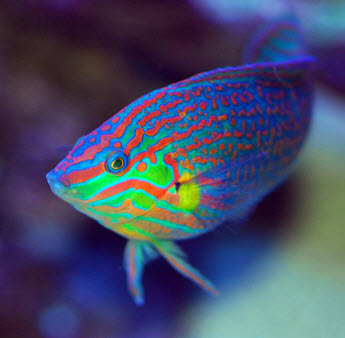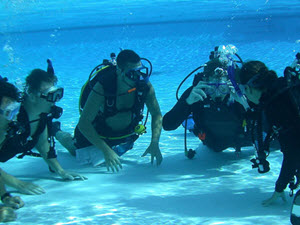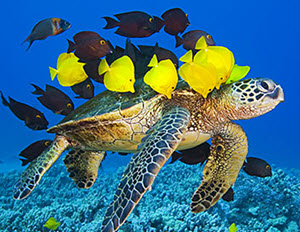 Learning to take good pictures underwater is an important part of become a successful naturalist. You will often see species you have never seen before and that you cant identify. When you do it is good if you are able to take a good photograph of the species in question so that you can identify it without having to catch the fish or rely on your memory when you get home. Being able to take good photographs also makes it possible to share your hobby with others and hopefully attract more people to the wonderful hobby of fish watching. If you are lucky you might be able to make some money from your pictures and offset some of your expenses or even become able to make a living from your diving.
Learning to take good pictures underwater is an important part of become a successful naturalist. You will often see species you have never seen before and that you cant identify. When you do it is good if you are able to take a good photograph of the species in question so that you can identify it without having to catch the fish or rely on your memory when you get home. Being able to take good photographs also makes it possible to share your hobby with others and hopefully attract more people to the wonderful hobby of fish watching. If you are lucky you might be able to make some money from your pictures and offset some of your expenses or even become able to make a living from your diving.
There are 3 main elements that will affect your ability to take good photographs under water. They are:
- Buoyancy and control in the water
- Good lightening
- The quality of your camera
All 3 elements are important factors in taking good pictures. I would however list their importance in the order they are listed above. This is due to the fact that lightening and a good camera doesn’t matter if you haven’t mastered buoyancy. Without good light it doesn’t matter how good your camera is. You will still get bad pictures.
Buoyancy
 Buoyancy is extremely important as a naturalist diver. Much more important than it is if you are a regular diver. This is true regardless of whether you want to take photos or not. You need to be able to effortlessly stay motionless in water. Many certification courses only require you to be able to float motionless with the tip of your fins resting on the bottom. This is not enough for a naturalist. Being able to float motionless on any depth and on any water level is essential if you want to be able to observe marine life without scaring them or interfering in their behavior. As such you should not only be able to keep neutral buoyancy anywhere in the water column but also in any position. I can not stress enough how important it is to to have as near perfect control of your buoyancy as possible. I therefore recommend that you start training buoyancy as soon as possible. You will not regret it when you are able to effortless follow fish into caves and other crevices and observe them while remaining motionless. Below you will find some exercises that I recommend you master as early as possible.
Buoyancy is extremely important as a naturalist diver. Much more important than it is if you are a regular diver. This is true regardless of whether you want to take photos or not. You need to be able to effortlessly stay motionless in water. Many certification courses only require you to be able to float motionless with the tip of your fins resting on the bottom. This is not enough for a naturalist. Being able to float motionless on any depth and on any water level is essential if you want to be able to observe marine life without scaring them or interfering in their behavior. As such you should not only be able to keep neutral buoyancy anywhere in the water column but also in any position. I can not stress enough how important it is to to have as near perfect control of your buoyancy as possible. I therefore recommend that you start training buoyancy as soon as possible. You will not regret it when you are able to effortless follow fish into caves and other crevices and observe them while remaining motionless. Below you will find some exercises that I recommend you master as early as possible.
- The first exercise you should master is standing on your flippers while keeping your body motionless a few inches from the bottom of the ocean. You usually need to master this as a part of your certification.
- Repeat the exercise above but this time you should remove the flippers from the sea bed once you reached buoyancy and keep all of you floating motionless 4 inches above the bottom.
- Learn to go down to the bottom and float motionless 4 inches from the ground without ever letting your flippers or other body part touch the bottom or other object.
- While hovering over the bottom. Learn to raise and lower yourself carefully inch by inch simply by changing your Buoyancy.
- Learn to stay motionless higher up in the water column.
- Learn to keep a motionless with a neutral buoyancy while being upside down. IE with your tank towards the bottom and your face to the surface. This is considerable much harder than anything you tried before but is very useful to observe wildlife under overhangs and in caves.
- Learn to “sit” in the water using neutral buoyancy as your chair. This can be very comfortable and a good way to rest during the dive
Once you learned these techniques you should know enough to adapt to most situations you can encounter as a naturalist diver and everything you need to take good pictures since you have turned your body into a stable tripod for your camera.
Lightening
 On land and near the surface you usually get enough light from the sun to take good pictures. This quickly changes as you go down in the water column. A mere 30 ft down it might seem bright to the naked eye but you will experience problems taking good pictures without an additional source of lightening. If you do not use an extra source of light you will get pictures that do not reflect the true colors of the things you are photographing. This is due to the fact the different colors of light are able to penetrate to different depths. Red light is the first to get diffused when you go down deeper in the water and it is the first color that you loose without a good light source. The light source should ideally be placed a distance from the camera to provide light from a suitable angle. You can either choose to buy a camera with a flash or a separate source of lightening. I recommend the later as it gives you more choices and more control over the light.
On land and near the surface you usually get enough light from the sun to take good pictures. This quickly changes as you go down in the water column. A mere 30 ft down it might seem bright to the naked eye but you will experience problems taking good pictures without an additional source of lightening. If you do not use an extra source of light you will get pictures that do not reflect the true colors of the things you are photographing. This is due to the fact the different colors of light are able to penetrate to different depths. Red light is the first to get diffused when you go down deeper in the water and it is the first color that you loose without a good light source. The light source should ideally be placed a distance from the camera to provide light from a suitable angle. You can either choose to buy a camera with a flash or a separate source of lightening. I recommend the later as it gives you more choices and more control over the light.
Camera
 A good camera is one of the best purchases you can make as a naturalist diver. It is the last piece of the puzzle of taking great picture under water. Taking great pictures is not only fun it is also essential for being able to identify species when you get back home. A good underwater camera can unfortunately be very expensive. A cheaper option is to buy a underwater housing for your regular camera. This can be a decent option and it is possible to take good pictures with a camera housing but a camera that is designed to be used underwater from the start will always be a better option.
A good camera is one of the best purchases you can make as a naturalist diver. It is the last piece of the puzzle of taking great picture under water. Taking great pictures is not only fun it is also essential for being able to identify species when you get back home. A good underwater camera can unfortunately be very expensive. A cheaper option is to buy a underwater housing for your regular camera. This can be a decent option and it is possible to take good pictures with a camera housing but a camera that is designed to be used underwater from the start will always be a better option.
When you are looking for an underwater camera you should make sure to choose a digital camera. Photography and under water photography is a numbers game and the more pictures you can take the higher the chance that of of them is great. For the same reason you want a camera that is able to take a lot of pictures in a short amount of time.
Make sure that you chose a camera that suits you. If you enjoy having a lot of control yourself you should chose a camera that offers you to tweak the settings a lot. If you prefer a more hands of approach you should chose a camera that has a good auto function. It is however still good if you can manually change settings when needed.

